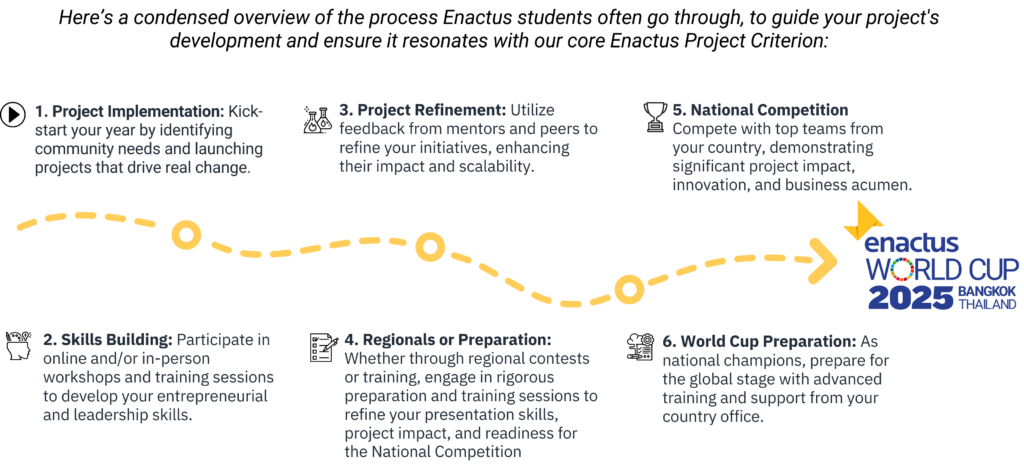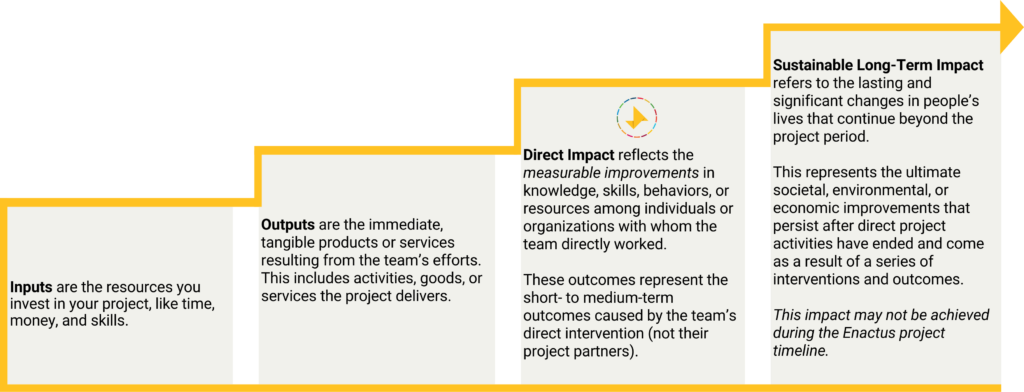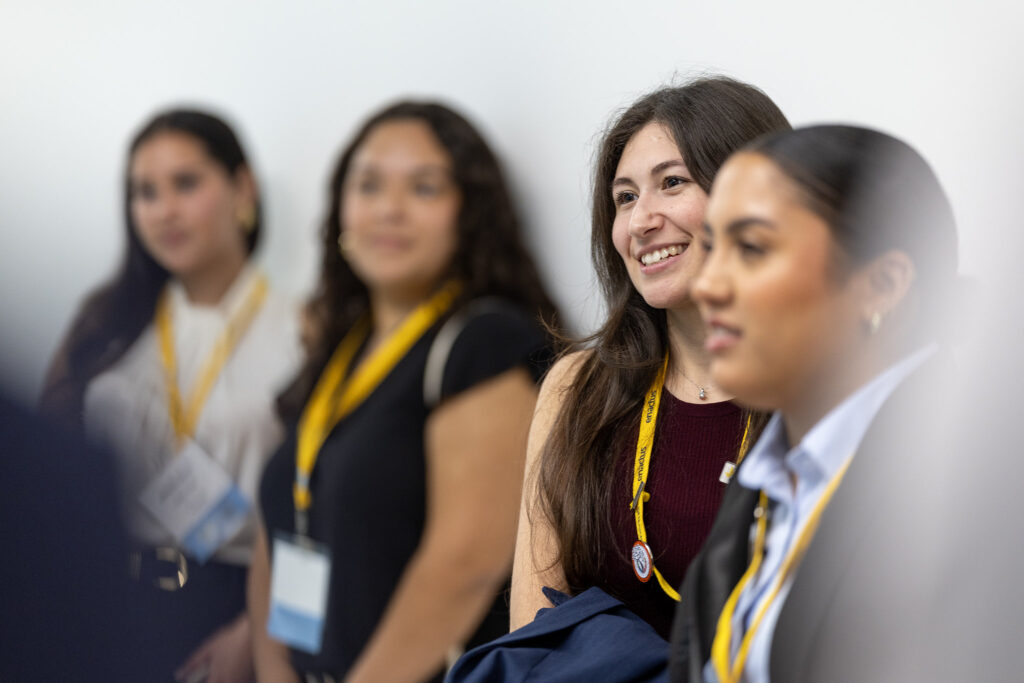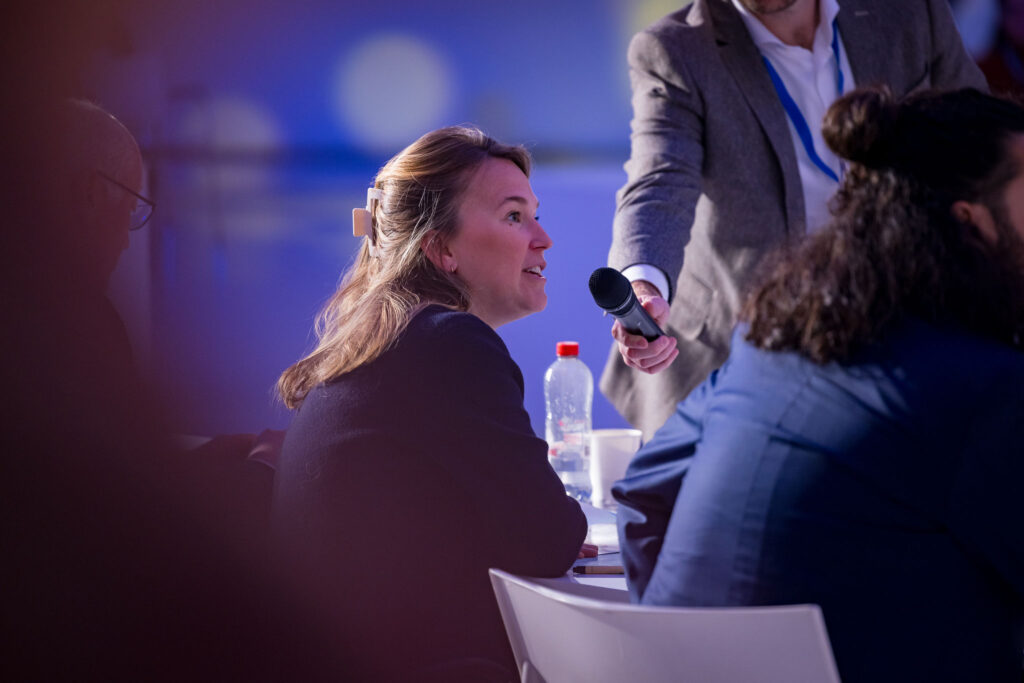ENACTUS
COMPETITION HANDBOOK
"Never doubt that a small group of thoughtful, committed people can change the
world.
Indeed, it's the only thing that ever has." —Margaret Mead
WELCOME TO ENACTUS COMPETITION SEASON.
Competition season is here, and your dedication over the past few months is about to shine! At Enactus, competition isn’t just about winning—it’s about fueling innovation, driving real-world change, and creating a better future together. This page is your go-to guide for navigating the Enactus competition process, whether you’re a student competitor or a faculty advisor. Here, you’ll find everything you need to:
- Develop high-impact projects aligned with the Enactus mission.
- Understand competition structure, evaluation criteria, and impact measurement.
- Effectively present your work to judges and global leaders.
- Showcase how your entrepreneurial action improves lives.
By following these guidelines, you’re not just competing—you’re contributing to meaningful societal change while pushing your team to be the best it can be and showcase your impact. Use this as your roadmap—from project conception to presentation—and take your team to the next level. Because when we compete to improve lives, #WeAllWin.
YOUR COMPETITION JOURNEY
ENACTUS CORE COMPETITION | Enactus Competitions offer a fantastic opportunity for students and teams to receive feedback from business leaders, connect with peers and entrepreneurs, learn, collaborate, and, of course, celebrate your journey and efforts.
This part focuses primarily on the Enactus Core Competition (also known as Enactus World Cup Qualifier in some countries), where your innovative projects are evaluated against our criterion, highlighting the impacts on people, planet, and prosperity. It’s your chance to compete for the title of National Champion and potentially represent your country at the Enactus World Cup.
OTHER COMPETITIONS | Enactus Country offices may also hold other types of competitions as part of their Regional and/or National events, such as:
- Early-stage competitions,
- Pitch competition,
- Activities or competitions relating to Special Competitions
- Other competitions organized by the Country
office.
Regional or National events may also offer special awards to recognize outstanding teams, faculty advisors, alumni, partners, etc.

ENACTUS TEAM & COMPETITION GUIDELINES
Enactus teams operate within a global framework designed to foster entrepreneurial action, innovation, and impact. While teams have flexibility in organization and project development, certain foundational guidelines ensure fairness, transparency, and alignment with Enactus’ mission.
Here’s what you need to know:
Single Team Rule
Each institution / university may have only one Enactus team. Multi-campus universities can have separate teams if each has its own Faculty Advisor. Some countries may have additional criteria.
Faculty Advisor Requirement
Every team must have a Faculty Advisor employed by the institution, with no restrictions on their role.
Flexible Team Structure
Teams have the flexibility to structure themselves in a way that best suits their local context. However, some Enactus countries have specific requirements for team organization, so be sure to check with your Country Leader or Program Manager for any local guidelines.
Project Development
Teams have full freedom to design projects within the Enactus Criterion, choosing their beneficiaries and approach. Enactus staff are available for guidance.
Audit & Compliance
Teams competing in the Enactus World Cup must pass an audit by their country office to ensure fairness. Audits can occur at any time, so teams should maintain year-round readiness and are encouraged to keep good documentation of their activities. The official reporting period for teams participating in the Enactus World Cup 2025 is 1 September 2024 – 31 August 2025.
MANDATORY REPORTING
Before participating in their National Competition, teams are required to submit three key documents and reports, the Project Report Form & Team Information Sheet and the Project Verification Sheet.
This helps Enactus gain a deeper understanding of our global program impact, allowing us to continuously improve programming, events, and resources to better support teams worldwide.
Project Report Form
Enactus teams are required to submit their Project Report Form (information about your projects) & Team Information Sheet (information about your team) at least two weeks before the National Competition. You can find the Project Report Form here.
Project Verification Form
Every team must request that their Faculty Advisor, one student and one administrator (e.g. dean, department chair or institution president) review their Annual Report and sign the Project Verification Form. The form needs to be submitted to your Enactus country office, prior to competition.
THE ENACTUS PROJECT CRITERION
As Enactus students, you’re at the forefront of entrepreneurial action, driving social innovation. Enactus Projects all over the world follow a simple framework that guides the creation of new projects, called the Enactus Criterion. It is used to evaluate your realized outcomes & direct impact at Regional, National and Global Enactus competitions. This section helps you understand how to effectively measure and report your project’s real-world and direct impact, ensuring your initiatives contribute positively to people, planet, and prosperity. It’s your chance to highlight the depth of your contribution and the tangible difference your project makes.
The Enactus Project Criterion reads as follows:
Which Enactus team most effectively demonstrated entrepreneurial
leadership to drive business and innovation for sustainable positive
impact to benefit people, planet, and prosperity within the last year?
Now, let’s explore the essence of the Enactus criterion and how the different parts of it can guide you in structuring your presentation to effectively showcase the impactful outcomes you’ve achieved:
Entrepreneurial Leadership
Identifying a need and capitalizing on opportunities by taking personal responsibility, managing risk, and managing change within a dynamic environment.
Tips:
- Your team should demonstrate the capability to lead and develop the project, leveraging skills within the team and from partnerships.
- Effective use of resources and establishing a supportive network, ensuring your team’s ownership and operational control of the project.
- A solid foundation for your project through a thorough needs assessment informing its direction.
Enactus Example
A team in India identified a lack of accessible clean drinking water in rural villages. Instead of waiting for external aid, they:
- Designed a low-cost filtration system using locally sourced materials.
- Partnered with community members to distribute and educate people on water purification.
- Took personal responsibility by testing, iterating, and scaling their solution to serve multiple villages.
How to Showcase in a Presentation?
- Describe how your team identified the problem and took initiative to address it.
- Highlight how you managed risks, challenges, and change throughout the project.
Business Principles
Applying a sound business model and business plan.
Tips:
- A robust, clear, and comprehensive business model incorporating strategy, marketing, and logistics.
- Financial self-sufficiency highlighted by a logical and complete financial plan.
- Proof of income generated in the past year, reflecting the project’s financial health.
- A strategy for scaling the project from a student initiative to a sustainable enterprise.
Enactus Example:
A team in Kenya built an eco-friendly briquette business to replace charcoal. They:
- Developed a self-sustaining business model, selling briquettes made from agricultural waste.
- Used customer research to set the right pricing and distribution strategy.
- Reinvested profits to train more women entrepreneurs, ensuring financial sustainability.
How to Showcase in a Presentation?
- Explain how your project is financially viable and not just a one-time intervention.
- Share business model details like revenue streams, partnerships, and scaling plans.
Innovation
The process of introducing new or improving existing ideas, services, technologies, products, or methodologies.
Tips: Implementation or improvement of new ideas, technologies, or methods in the past year.
Enactus Example:
A team in Brazil tackled food waste in urban areas. They:
- Developed an AI-powered app that connects restaurants with surplus food to NGOs feeding people in need.
- Introduced a tracking system to measure food saved and people fed.
- Improved upon existing food redistribution methods by reducing food waste by 40% in their pilot phase.
How to Showcase in a Presentation?
- Highlight what makes your solution unique, scalable, or an improvement over existing methods.
- Use visuals to demonstrate the before-and-after impact of your innovation.
Sustainable Positive Impact
Demonstrating a measurable, lasting improvement for people, planet, and prosperity.* (prosperity = fulfilling lives economically and socially)
Tips:
- Evident resolution of the identified issue through the project’s actions.
- Advancements in social, environmental, and economic areas, as reflected by the project’s initiatives over the past year.
- Detailed measurement of the project’s impact, showing direct influence and clear before/after comparisons.
Enactus Example
A team from the UK tackled fast fashion waste while supporting unemployed individuals. They:
- Upcycled 5,000+ garments, turning textile waste into professional workwear.
- Provided free interview clothing and coaching in partnership with job centers.
- Hired job seekers to work in the social enterprise, gaining skills in retail, tailoring, and business operations.
- Created a self-sustaining model, reinvesting sales revenue into job training and employment programs.
How to Showcase in a Presentation?
- Share real stories of individuals who gained jobs through the initiative.
- Highlight direct impact metrics (garments saved, jobs created, waste reduced).
- Show how the project empowers people while promoting sustainability.
DEVELOPING YOUR PROJECT
Aligning your Enactus project with the Sustainable Development Goals (SDGs) offers a powerful framework to ensure your initiatives contribute meaningfully to local, regional and global challenges. Here’s a condensed overview of everything you have learned this year, to guide your project’s development and ensure it resonates with our core criteria of Entrepreneurial Leadership, Business Principles, Innovation, and Sustainable Positive Impact.
- Identify Community Needs: Use the SDGs as a starting point to
understand and articulate the specific needs your project aims to address,
considering economic, social, and environmental factors. This aligns with
Entrepreneurial Leadership by recognizing opportunities for impactful
action within your community. - Target Audience Engagement: Engage directly with your target audience
to deeply understand their needs and aspirations. This approach not only
embodies Entrepreneurial Leadership but also ensures your project’s
outcomes are directly beneficial to them, contributing to Sustainable
Positive Impact. - Innovative Solutions: Craft your project around innovative solutions that are economically viable, socially equitable, and environmentally
sustainable. This directly ties into Innovation and Use of Business
Principles, ensuring your project is grounded in sound business
Ethical Considerations: Ethical mindfulness in project planning and
execution is crucial. Ensure you’re following guidelines for ethical
community engagement and data collection, underpinning the integrity
and sustainability of your project’s impact.Partnership for Impact: When partnering on projects, it’s crucial to
emphasize that the focus is on the impact created by the student-led team’s efforts, rather than the partner’s contributions. Collaborations
should enhance the project’s reach and effectiveness, but the primary
measurement of success is the change your team directly facilitates. Always articulate your role clearly in the partnership and ensure that the project’s outcomes can be attributed to your team’s innovative and
entrepreneurial actions.Link with SDGs: Explicitly connect your project’s objectives and impact to specific SDGs, illustrating how your team is contributing to broader local and global impact.
REMEMBER: Your projects should not just aim for immediate results (outputs) but strive for lasting benefits (direct impact) that contribute to people, planet, and prosperity. Keep focusing on real, measurable impacts that align with the SDGs to demonstrate how your project contributes to global goals, showcasing the full spectrum of Entrepreneurial Leadership, Innovation, Business Principles, and Sustainable Positive Impact.
IMPACT DEFINITIONS & MEASURING IMPACT
When developing Enactus projects, it’s crucial to understand the core impact we and our projects are creating for people, planet, and prosperity. It’s not just about meeting the Enactus Project Criterion; it’s about generating positive, sustainable outcomes and impact now.
To understand and judge how successful projects are, teams need to know and articulate clearly the difference between what they put in (inputs), what they produce (outputs), the positive changes they create (direct & indirect impact – also known as outcomes), and the longer term and wider impact they have (sustainable long-term impact).
Our Impact Definitions framework will help you effectively communicate your project’s impact to the judges and confidently present your project’s reach in a compelling way, whilst importantly ensuring your claims are accurate and fair.
RECOMMENDATION: For the most accurate and impactful reporting of your results, please familiarize yourself with the impact definitions.
Inputs
Inputs are the resources the team invests in their project, including time, money, and skills.
Outputs
Outputs are the immediate, tangible products or services resulting from the team’s efforts. This includes activities, goods, or services the project delivers.
Direct Impact
Direct Impact reflects the measurable improvements in knowledge, skills, behaviors, or resources among individuals or organizations with whom the team directly worked. These outcomes represent the short- to medium-term outcomes caused by the team’s direct intervention (not their project partners).
Example: As a result of a training organized by the team, 15 local seamstresses gained skills in upcycling techniques, pattern making, and fashion design.
Indirect Impact
Indirect Impact includes those who indirectly gain measurable improvements in knowledge, resources, or benefits from the project but with whom the team did not work directly. These outcomes contribute to broader positive changes for people, planet and prosperity in communities, as a result of the project’s ripple effect.
Example: Indirect impact can be seen in the improved well-being of the families of the local seamstresses, who now experience increased financial stability due to their mothers’ enhanced earning potential.
Reach
Reach measures the number of people exposed (e.g. media reach, awareness campaigns, application downloads etc.) to the project but does not necessarily indicate direct or indirect impact. While reach is an important metric, it does not reflect measurable change and therefore should not be classified as impact.
Income or Revenue
Income/Revenue refers to the total amount of financial resources a team and/or its project(s) has generated from activities such as sales, grants, sponsorships, or donations. This relates to income generated by the team, not by its project partners.
Profit or Surplus
Profit/Surplus is the money remaining after deducting all expenses from the income/revenue generated. This can be both team/project related.
Sustainable Long-Term Impact
Sustainable Long-Term Impact refers to the lasting and significant changes in people’s lives that continue beyond the project period. This represents the ultimate societal, environmental, or economic improvements that persist after direct project activities have ended and come as a result of a series of interventions and outcomes. This impact may not be achieved during the Enactus project timeline.
Projections
Projections show what might happen in the future, based on your current success. While helpful for showing long-term potential, judges will primarily focus on the actual impact you’ve achieved this year.
*IMPORTANT NOTE: In the Enactus context, we prioritize direct impact to ensure our projects create meaningful changes. Direct impact refers to the measurable benefits experienced by individuals you’ve directly worked with. These benefits include new knowledge, skills, or resources they’ve gained and applied, directly because of your project within the current academic year.

PRESENTATION FORMAT & IMPACT PERIOD
Having covered the Enactus criterion, impact definitions, team guidelines, and pre-Nationals reporting, let’s focus on the presentation format. This section outlines the structure for your pitch, essential for both National Competitions and the Enactus World Cup. We’ll guide you through timing, team composition, and setup to ensure you’re prepared to showcase your project’s impact and innovation effectively.
How to Prepare for your Presentation?
Your team will have a unique opportunity to showcase your project’s impact on a regional, national and/or global stage. Here’s the breakdown of the presentation time:
- Set-Up Period: 3 minutes for setting up and checking any audio-visual equipment. Once the team has set up, a plain black screen should be displayed. During this time it is suggested that the Annual Reports are handed out to the
judges (any student member can support this). - Presentation: 12 minutes to deliver your impactful presentation. Conclude with a blank screen and note that exceeding this limit will result in being cut off.
- Question and Answer Period: 5 minutes for judges’ questions, displayed against a black screen. If an interpreter is needed, the Q&A period extends to 10 minutes.
- Annual Report: During the set-up, distribute Annual Reports to judges. Remember, only Annual Reports are permissible; no products, prototypes, or other items can be distributed. See below section for more guidelines about the Annual Report.
*Note: Only student members of the competition team may participate in the presentation and answer questions from the judges.
Impact Reporting Guidelines for National and World Cup Competitions
- For the National Competition, teams must present only impact data and project implementations realized within the last 12 months, from the previous National Competition to the current one. This ensures that results showcased align with the Enactus Project Criterion and accurately reflect recent achievements.
- For teams advancing to the Enactus World Cup, the official impact reporting period is 1 September 2024 – 31 August 2025.
Reporting Multi-Year Project Impact
- Teams with multi-year projects (e.g., started in 2022 or 2023) may briefly mention past impact for context, but their evaluation must focus on impact achieved within the official reporting period (see above). This approach recognizes project continuity, which is essential for scaling initiatives into long-term, sustainable enterprises.
- To avoid confusion, Country Operations must ensure that teams clearly differentiate between past and current-year impacts before being approved to compete at the Enactus World Cup. The National Champion Audit serves as a checkpoint for Country Leaders to verify this distinction, ensuring teams meet reporting requirements before representing their country on the global stage.
National Competition Variations:
For a variety of reasons, some countries may opt for different presentation time guidelines, such as a 3-minute setup, 7-minute presentation and 7-minute Q&A format. Your country office will inform you of such adjustments to ensure you’re well-prepared.



ANNUAL REPORT & STANDARDIZED IMPACT PAGE
Every competing team must produce an annual report summarizing its projects, highlighting the impact over the last required impact period (see above). This document, mandatory to be shared with judges, should detail project descriptions, target beneficiaries, and actual impacts achieved.
Your report may consist of up to four single-sided A4 or 8 1⁄2″ X 11” pages, or you can opt for double-sided printing, with a maximum of two sheets used.
Stick within these guidelines without reducing the paper size or employing QR codes to bypass the page limit. Covers count towards your page count, and avoid using external folders or covers. Leftover reports will be recycled.
Tips for an effective Annual Report
- Focus exclusively on the past year, emphasizing actual impacts, not future projections.
- Clearly articulate the tangible impact achieved within this timeframe – see on the right.
- Utilize this report to complement your presentation, offering judges a concise, impactful overview of your team’s impact and work.
- Ensure the report is directly aligned with the Enactus Project Criterion,
reinforcing the project’s alignment with our goals.
Standardized Impact Page in Annual Reports: To enhance transparency and consistency, each team’s Annual Report must include one standardized page displaying impact and financial results based on Enactus’ official definitions (see definitions section). This ensures all teams present their outcomes in a clear, comparable format.
- Teams may report their impact per project or provide total impact across all projects within the official impact reporting cycle.
- Impact & Financial Definitions to be included in the Standardized Page:
- Direct Impact – Individuals or entities directly affected by the project.
- Indirect Impact – Broader influence on people or communities beyond direct involvement.
- Reach – Number of people informed through the project (e.g. media., awarenss campaigns).
- Projections – Expected future outcomes based on measurable trends.
- Financial Results:
- Income/Revenue – Money generated from the project.
- Profit/Surplus – Net financial gains after expenses.
This standardized impact table ensures a clear, measurable way to evaluate project success and promotes fair, consistent impact assessment at the Enactus World Cup.
Equipment
For your presentation at Enactus National Competitions or Enactus World Cup, be mindful of the provided and required equipment:
- Provided: Projector, screen, (HDMI) cable.
- Not provided: Laptops, HDMI connectors, and other presentation equipment. Teams must bring these.
- Consistency: The competition room setup will remain the same from the Tech Check to the competition.
- Country-specific details: Your country office will inform you about any specific equipment or setup details for your national competition.
Tech Checks: Before your presentation, you’ll be able to perform a tech check, which could be scheduled for the evening, morning, or afternoon prior to your presentation rounds. Your country office will provide further details and scheduling.
JUDGE PROCESS
To make the most of your presentation, it’s helpful to understand how the judges will be evaluating you. This section explains the judging process used in all competitions, including how judges are prepared for their role. This knowledge can help you tailor your presentation and increase your chances of success!
1. Judge Orientation
Judges receive training on how to evaluate teams according to the competition’s criteria including both a virtual and in-personal judge orientation.
2. Judge Oath
Every judge must agree to the Judges Oath which is the same oath that is used across the World. With this, they commit to providing fair and quality assessments of the teams’ overall programme.
3. Team Presentation
Introduced by the competition coordinator, each team will have 12-minutes to present their project to a panel of judges, followed by a 5-minute Q&A session.
4. Team Evaluation
During each presentation, judges use the Individual Team Evaluation Form (ITEF) to assess the quality and impact of teams’ initatives and score accordingly.
5. Team Ranking
Judges then use the Cumulative Evaluation Form (CEF) to assess and rank the teams with number one being 1st place, number two being 2nd place and so on.
6. Present at All Presentations
Judges must be present for all presentations in order for their
votes to be counted during the scoring process.

JUDGE OATH
On my honor, I agree to serve as an official judge of an Enactus competition with utmost fairness and impartiality.
I undertake this responsibility free from any prior conflicts of interest or preconceived notions about the competition’s outcomes.
I commit to basing my evaluations solely on the teams’ presentations and annual report, with a focused lens on the realized impact and tangible outcomes they have achieved.
My assessments will adhere strictly to the judging criteria provided, ensuring a just and equitable evaluation process.
IMPACT & FINANCIAL REPORTING REVIEW (PREVIOUSLY: AUDIT)
After the National Competition, the Champion team is subject to an in-depth Impact & Financial Reporting Review by the Enactus Country Office, as part of an Enactus Global auditing initiative.
Countries that have the capacity may even do pre-competition impact & financial reporting and/or additional (finalist) teams post-Competition.
What to expect from this review?
- All guidelines governing the Impact & Financial Reporting Review are provided by Enactus Global to Country Offices.
- The auditor may be the Country Leader, Head of Program, Program Manager, or someone in a similar position who has established a relationship with the team. Enactus staff may engage third-party auditors subject to certain protocols.
- The process is typically conducted within five weeks after the National event.
- Once the National Champion successfully passes the review, their team is eligible to represent their country at the Enactus World Cup.
- If the team fails the review, the first runner-up will be subject to the review process to determine their eligibility for the Enactus World Cup.
- The team that failed the audit has one week from the date of the formal email notification regarding the verdict sent by the Country Leader or Board Chair to appeal the decision.
PHASE 1: TEAM ENGAGEMENT
This involves interviews with key team members and advisors, alongside document reviews to ensure information accuracy presented at Nationals.
PHASE 2: TEAM OPERATION REVIEW
This phase assesseses the team’s capacity, resources, and infrastructure, including financial scrutiny.
PHASE 3: PROJECT REVIEW & SITE VISITS
This phase seeks to gain insight on the team’s projects including planning, processes and achieved results. This may include (but is not limited to) project site visits, interviews with beneficiaries, stakeholder questionnaires and other means of research to verify the project information reported by the team.
How can a team fail a Reporting Review?
Teams may not pass the review, if there is a case of material infractions. Such material infractions could include, although are not limited to following:
- The Project never existed.
- The Project need has been exaggerated.
- Project results and outcomes have been exaggerated.
- Actions or outcomes taken by third-parties, presented intentionally as if they were taken by the team.
- The team has falsified information on team structure, membership or finances.
- Actions or outcomes from prior years presented intentionally to mislead that they were achieved in current year.
Pre-World Cup Reporting Requirements
Teams that successfully pass the Impact & Financial Reporting Review and earn the right to represent their country at the Enactus World Cup will receive full support from their country office in preparation for the competition.
Aligned with Enactus values of collaboration, integrity, passion, and innovation, we have refined our Impact & Financial Reporting Review process for 2024 to ensure fairness and consistency across all teams, regardless of project scope or scale.
To ensure transparency and uphold competition integrity for the Enactus World Cup, country offices must submit the following documentation to Enactus Global by 1 September 2025 at 18:00 GMT:
- Team’s Presentation Script
- Team’s Annual Report, including the Standardized Impact Table *
* Teams must ensure these numbers align with the official Enactus Impact Definitions.

TOP TIPS FOR THE IMPACT & FINANCIAL REPORTING REVIEW
Plan Ahead – Don’t wait! Integrate self-reviews into your regular operations to track impact and finances year-round.
Assign a Lead – Have a team member or faculty advisor oversee documentation and reporting.
Keep Clear Records – Maintain organized data on:




Prepare Beneficiaries – Inform them early that they may be contacted for verification.
Be Transparent – Ensure data aligns with Enactus’ impact and financial definitions to avoid misrepresentation.

FREQUENTLY ASKED QUESTIONS
1. Who can participate in the Enactus Competition?
Enactus competitions are open to officially recognized Enactus teams from universities and colleges. Each institution can have only one team, unless it has multiple campuses with separate Faculty Advisors.
2. What are the key reporting requirements before competing in Nationals?
Before participating in your National Competition, your team must submit:


These documents help Enactus assess global program impact and improve future events and programming.
3. What is the official impact reporting period for competitions?
National Competitions: Impact data must reflect outcomes achieved between the last and current national competition.
Enactus World Cup 2025: Teams report impact from 1 September 2024 – 31 August 2025.
For multi-year projects, teams may briefly mention past achievements for context, but only the current-year impact is evaluated.
4. What is the Impact & Financial Reporting Review?
This review ensures that teams accurately report their project impact and financial results before competing at the Enactus World Cup. National Champion teams undergo this review after their National Competition.
This Review was previously called the Audit.
5. What happens if a team fails the Impact & Financial Reporting Review?
If a team does not pass, the first runner-up may undergo the review to determine their eligibility for the Enactus World Cup. Teams have one week to appeal the decision if they fail.
6. What information must be included in the Annual Report?
What is the Annual Report?
A required document summarizing your team’s projects, impact, and financial results over the past year. It must be shared with judges during competitions.
What are the page limits?
Teams may submit up to four single-sided pages (A4 or 8 ½” x 11”), or two double-sided sheets. Covers count toward the limit, and QR codes to bypass the limit are not allowed.
What must be included in the Annual Report?



- Direct Impact (individuals directly affected)
- Indirect Impact (broader influence)
- Reach (awareness campaigns, media)
- Projections (expected future outcomes)
- Financial results (income/revenue & profit/surplus)
Why is the Standardized Impact Page required?
To ensure fair, consistent, and measurable impact reporting across all teams competing at the Enactus World Cup and National Competitions.
What happens if we don’t follow these guidelines?
Failure to comply may result in disqualification from the competition.
7. Can teams present financial and impact projections?
Teams can include projections in their presentation and Annual Report, but they must clearly differentiate projections from actual impact and financial results. The teams are being assessed based on their actual & realized impact, not based on projections.
8. What is the role of the Country Leader & Program Staff in impact reporting?
Country Leaders play a crucial role in ensuring transparency and consistency in impact reporting. They are responsible for:




By upholding these standards, Country Leaders and Program Staff safeguard the fairness, credibility, and integrity of the competition.
9. Can teams use past project impact in their presentations?
Teams with multi-year projects may reference past impact for context but must focus their evaluation on results within the official reporting period.
10. How can teams prepare for the Impact & Financial Reporting Review?





11. What equipment is provided at competitions?
Enactus provides:
Teams must bring their own:
Laptops, HDMI adapters, or additional presentation equipment
Always double check with your country office, as this may vary per country.
12. How does the judge process work?
Judges follow a structured evaluation process, including:
- Orientation on Enactus Project Criterion
- Taking the Judge’s Oath for fairness and impartiality
- Evaluating presentations and annual reports
- Using the Individual Team Evaluation Form (ITEF) and Cumulative Team Evaluation Form (CTEF) for scoring
- Ranking teams based on cumulative assessments
13. What are the key presentation rules?
How much time do teams have for their presentation?
- Set-Up: 3 minutes to prepare and check equipment while displaying a black screen.
- Presentation: 12 minutes to deliver the presentation. Exceeding this time will result in being cut off.
- Q&A: 5 minutes for judges’ questions, or 10 minutes if an interpreter is used.
Can teams distribute materials to judges?
- Only Annual Reports may be handed out during the set-up period. No products, prototypes, or other materials are allowed.
What should be displayed on the screen before and after the presentation?
- A plain black screen must be shown before and after the presentation.
14. Where can I find official guidelines and definitions?
All teams must align with Enactus’ official impact and financial definitions, as listed on this Enactus Competition Handbook webpage.


